air condition TOYOTA LAND CRUISER 2013 J200 Workshop Manual
[x] Cancel search | Manufacturer: TOYOTA, Model Year: 2013, Model line: LAND CRUISER, Model: TOYOTA LAND CRUISER 2013 J200Pages: 720, PDF Size: 21.46 MB
Page 575 of 720
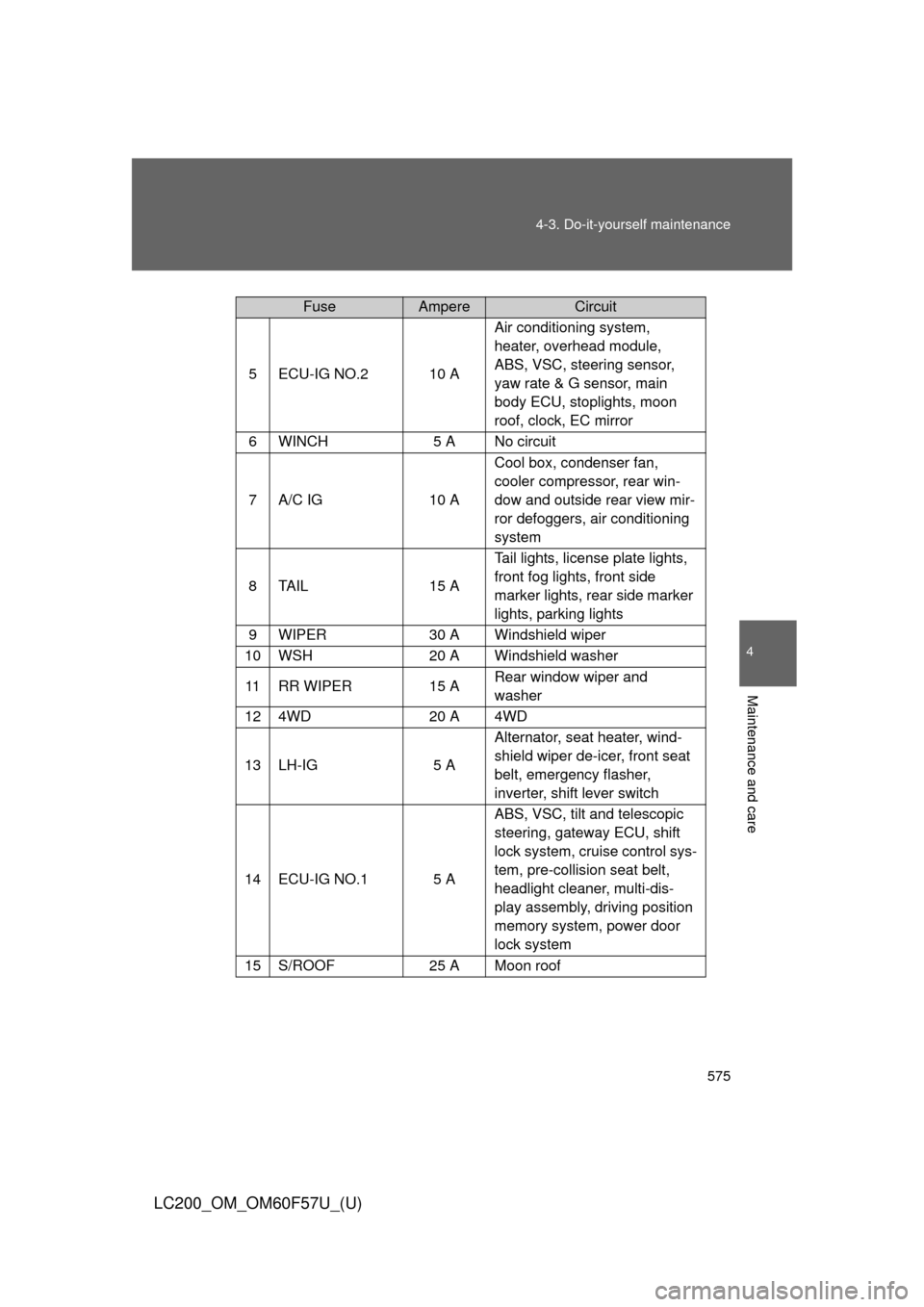
575 4-3. Do-it-yourself maintenance
4
Maintenance and care
LC200_OM_OM60F57U_(U)
5ECU-IG NO.210 AAir conditioning system,
heater, overhead module,
ABS, VSC, steering sensor,
yaw rate & G sensor, main
body ECU, stoplights, moon
roof, clock, EC mirror
6WINCH5 A No circuit
7A/C IG10 ACool box, condenser fan,
cooler compressor, rear win-
dow and outside rear view mir-
ror defoggers, air conditioning
system
8TA I L15 ATail lights, license plate lights,
front fog lights, front side
marker lights, rear side marker
lights, parking lights
9WIPER30 A Windshield wiper
10WSH20 A Windshield washer
11RR WIPER15 ARear window wiper and
washer
124WD20 A 4WD
13LH-IG5 AAlternator, seat heater, wind-
shield wiper de-icer, front seat
belt, emergency flasher,
inverter, shift lever switch
14ECU-IG NO.15 AABS, VSC, tilt and telescopic
steering, gateway ECU, shift
lock system, cruise control sys-
tem, pre-collision seat belt,
headlight cleaner, multi-dis-
play assembly, driving position
memory system, power door
lock system
15S/ROOF25 A Moon roof
FuseAmpereCircuit
Page 576 of 720
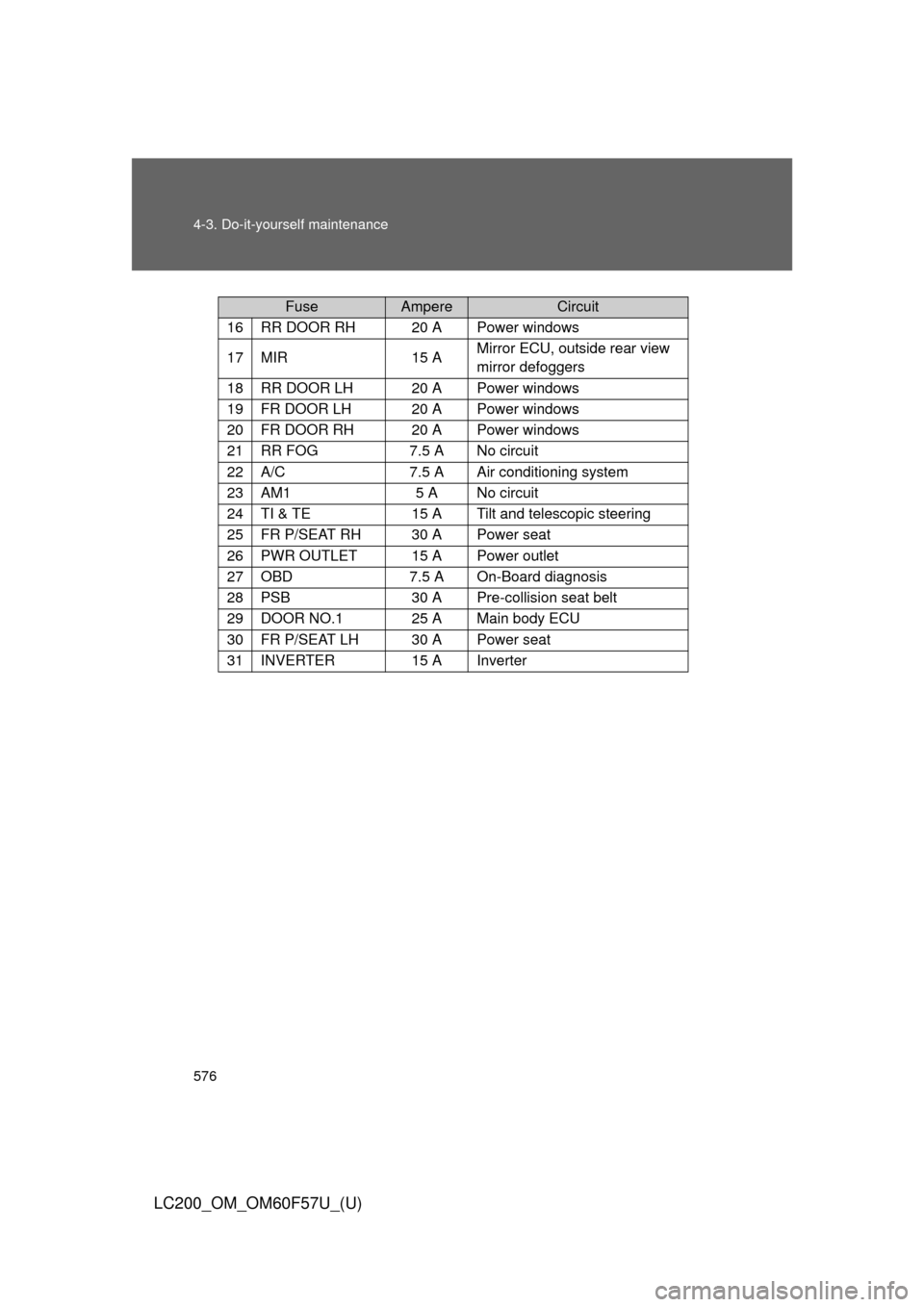
576 4-3. Do-it-yourself maintenance
LC200_OM_OM60F57U_(U)
16RR DOOR RH20 A Power windows
17MIR15 AMirror ECU, outside rear view
mirror defoggers
18RR DOOR LH20 A Power windows
19FR DOOR LH20 A Power windows
20FR DOOR RH20 A Power windows
21RR FOG7.5 A No circuit
22A/C7.5 A Air conditioning system
23AM15 A No circuit
24TI & TE15 A Tilt and telescopic steering
25FR P/SEAT RH30 A Power seat
26PWR OUTLET15 A Power outlet
27OBD7.5 A On-Board diagnosis
28PSB30 A Pre-collision seat belt
29DOOR NO.125 A Main body ECU
30FR P/SEAT LH30 A Power seat
31INVERTER15 A Inverter
FuseAmpereCircuit
Page 604 of 720
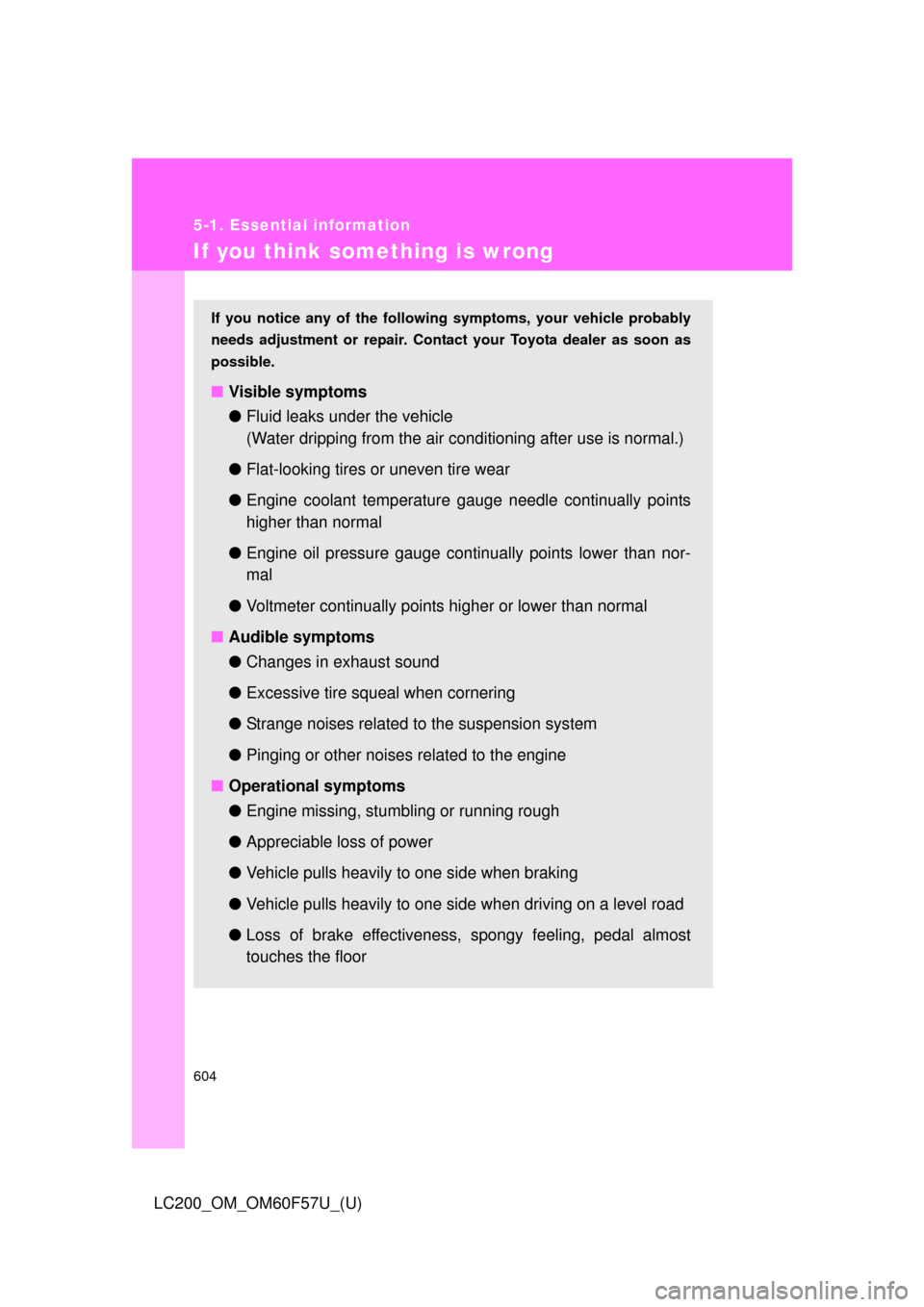
604
5-1. Essential information
LC200_OM_OM60F57U_(U)
If you think something is wrong
If you notice any of the following symptoms, your vehicle probably
needs adjustment or repair. Contact your Toyota dealer as soon as
possible.
■Visible symptoms
●Fluid leaks under the vehicle
(Water dripping from the air conditioning after use is normal.)
●Flat-looking tires or uneven tire wear
●Engine coolant temperature gauge needle continually points
higher than normal
●Engine oil pressure gauge continually points lower than nor-
mal
●Voltmeter continually points higher or lower than normal
■Audible symptoms
●Changes in exhaust sound
●Excessive tire squeal when cornering
●Strange noises related to the suspension system
●Pinging or other noises related to the engine
■Operational symptoms
●Engine missing, stumbling or running rough
●Appreciable loss of power
●Vehicle pulls heavily to one side when braking
●Vehicle pulls heavily to one side when driving on a level road
●Loss of brake effectiveness, spongy feeling, pedal almost
touches the floor
Page 613 of 720

5
When trouble arises
613 5-2. Steps to take in an emergency
LC200_OM_OM60F57U_(U)
■When a tire is replaced with a spare tire
The spare tire is also equipped with the tire pressure warning valve and
transmitter. The tire pressure warning light will turn on if the tire inflation
pressure of the spare tire is low. If a tire goes flat, even though the flat
tire is replaced with the spare tire, the tire pressure warning light does
not turn off. Replace the spare tire with the repaired tire and adjust the
proper tire inflation pressure. The tire pressure warning light will turn off
after a few minutes.
■If the tire pressure warning system is inoperative
The tire pressure warning system will be disabled in the following condi-
tions:
(When the condition becomes normal, the system will work properly.)
●If tires not equipped with tire pressure warning valves and transmit-
ters are used.
●If the ID code on the tire pressure warning valves and transmitters is
not registered in the tire pressure warning computer.
●If the tire inflation pressure is 73 psi (500 kPa, 5.1 kgf/cm2 or bar) or
higher.
The tire pressure warning system may be disabled in the following condi-
tions:
(When the condition becomes normal, the system will work properly.)
●If electronic devices or facilities using similar radio wave frequencies
are nearby.
●If a radio set at similar frequencies is in use in the vehicle.
●If a window tint that affects the radio wave signals is installed.
●If there is a lot of snow or ice on the vehicle, in particular around the
wheels or wheel housings.
●If non-genuine Toyota wheels are used. (Even if you use Toyota
wheels, the tire pressure warning system may not work properly with
some types of tires.)
●If tire chains are used.
●If the spare tire is in a location subject to poor radio wave signal
reception.
●If a large metallic object which can interfere with signal reception is
put in the luggage compartment.
Page 659 of 720
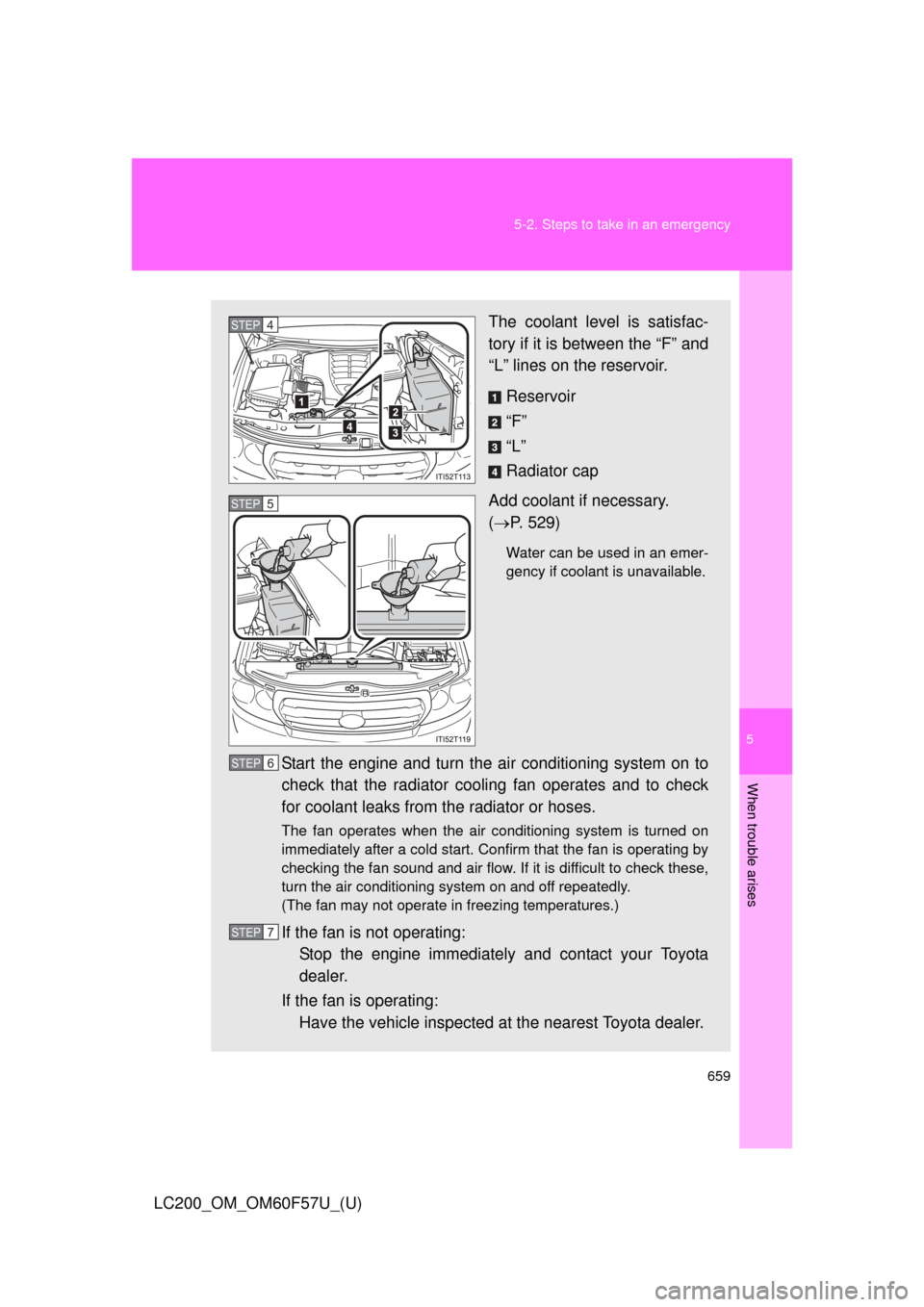
5
When trouble arises
659 5-2. Steps to take in an emergency
LC200_OM_OM60F57U_(U)
The coolant level is satisfac-
tory if it is between the “F” and
“L” lines on the reservoir.
Reservoir
“F”
“L”
Radiator cap
Add coolant if necessary.
(P. 529)
Water can be used in an emer-
gency if coolant is unavailable.
Start the engine and turn the air conditioning system on to
check that the radiator cooling fan operates and to check
for coolant leaks from the radiator or hoses.
The fan operates when the air conditioning system is turned on
immediately after a cold start. Confirm that the fan is operating by
checking the fan sound and air flow. If it is difficult to check these,
turn the air conditioning system on and off repeatedly.
(The fan may not operate in freezing temperatures.)
If the fan is not operating:
Stop the engine immediately and contact your Toyota
dealer.
If the fan is operating:
Have the vehicle inspected at the nearest Toyota dealer.
STEP4
STEP5
STEP6
STEP7
Page 685 of 720
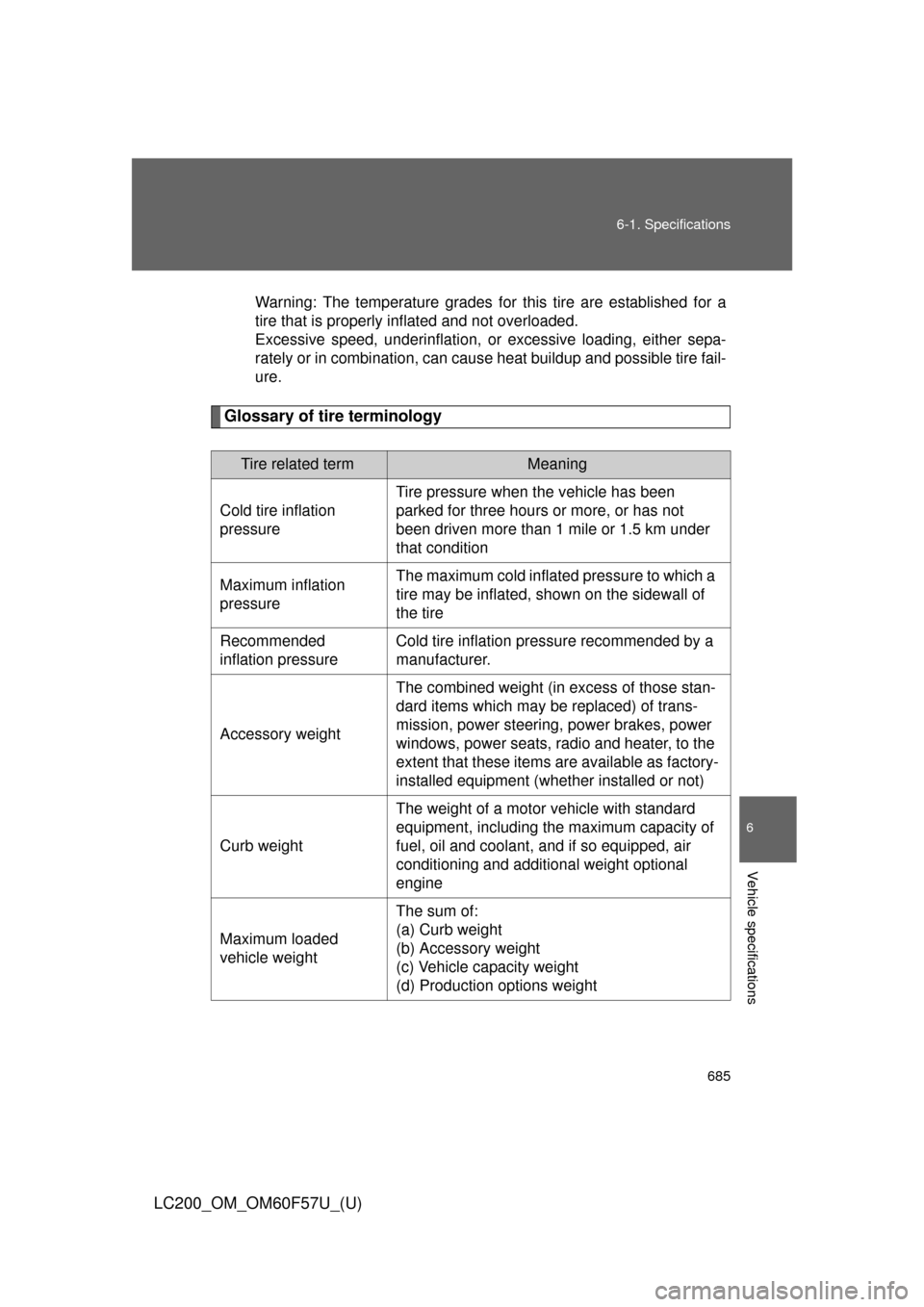
685 6-1. Specifications
6
Vehicle specifications
LC200_OM_OM60F57U_(U)
Warning: The temperature grades for this tire are established for a
tire that is properly inflated and not overloaded.
Excessive speed, underinflation, or excessive loading, either sepa-
rately or in combination, can cause heat buildup and possible tire fail-
ure.
Glossary of tire terminology
Tire related termMeaning
Cold tire inflation
pressureTire pressure when the vehicle has been
parked for three hours or more, or has not
been driven more than 1 mile or 1.5 km under
that condition
Maximum inflation
pressureThe maximum cold inflated pressure to which a
tire may be inflated, shown on the sidewall of
the tire
Recommended
inflation pressureCold tire inflation pressure recommended by a
manufacturer.
Accessory weightThe combined weight (in excess of those stan-
dard items which may be replaced) of trans-
mission, power steering, power brakes, power
windows, power seats, radio and heater, to the
extent that these items are available as factory-
installed equipment (whether installed or not)
Curb weightThe weight of a motor vehicle with standard
equipment, including the maximum capacity of
fuel, oil and coolant, and if so equipped, air
conditioning and additional weight optional
engine
Maximum loaded
vehicle weightThe sum of:
(a) Curb weight
(b) Accessory weight
(c) Vehicle capacity weight
(d) Production options weight
Page 698 of 720

698 6-2. Customization
LC200_OM_OM60F57U_(U)
Automatic
light control
system
(P. 196)Light sensor sen-
sitivityStandard -2 to 2 O — O
Daytime running
light systemOn Off O — O
Time elapsed
before head-
lights automati-
cally turn off after
doors are closed30 secondsOff
O—O 60 seconds
90 seconds
Intuitive
parking
assist
(P. 229)Detection dis-
tance of the rear
center sensorFar Near O — O
Alert Volume
(alert volume can
be adjusted)3 1 to 5 O — O
Display setting
(when intuitive
parking assist is
operating)All sensors
displayedDisplay off O — O
Automatic
air
conditioning
system
(P. 336)A/C Auto switch
operationAuto Manual O — O
Eco Driving
Indicator
Light
(P. 156)Eco Driving
Indicator LightOn Off — O O
ItemFunctionDefault
settingCustomized
setting
Page 705 of 720
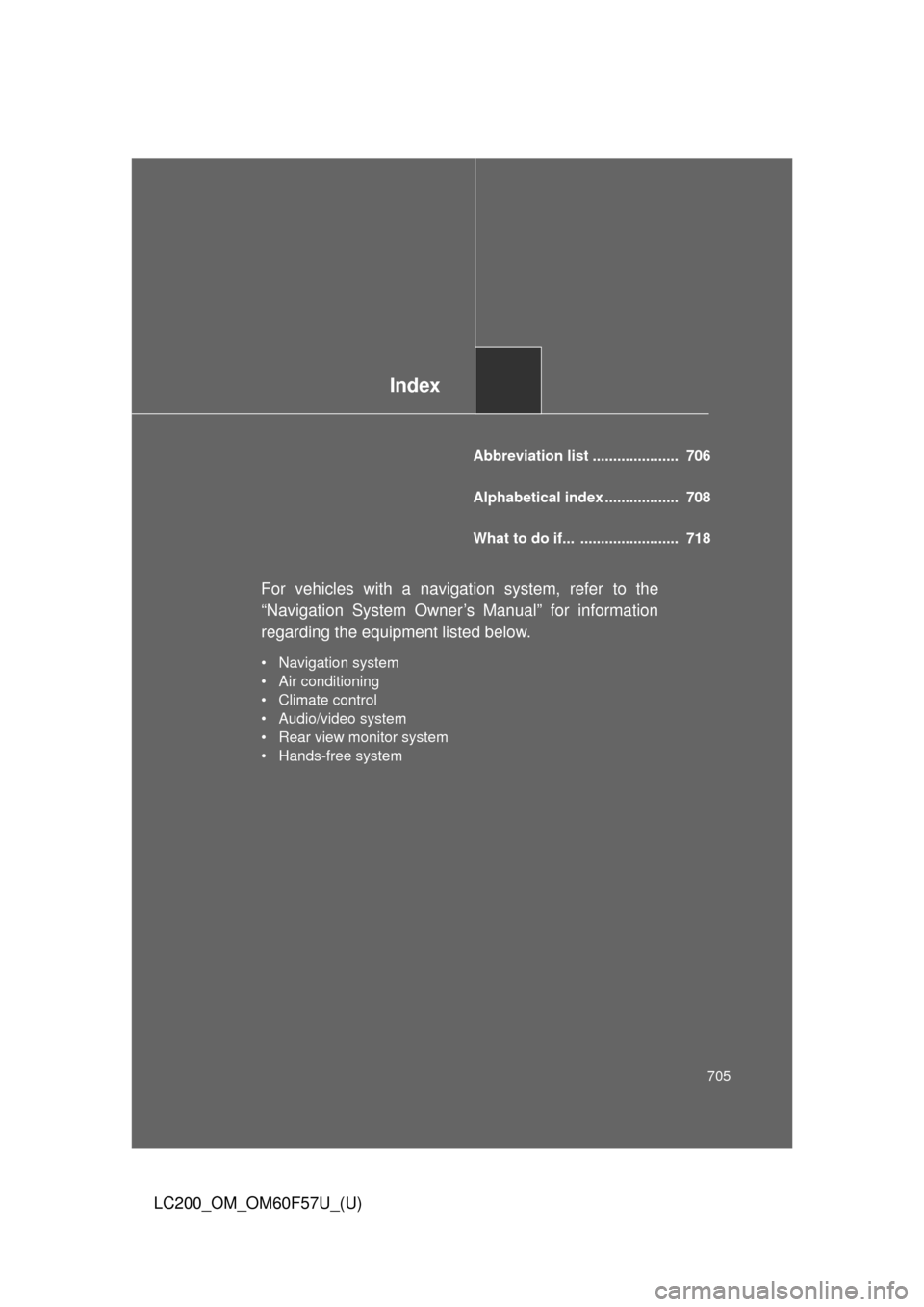
Index
705
LC200_OM_OM60F57U_(U)
Abbreviation list ..................... 706
Alphabetical index .................. 708
What to do if... ........................ 718
For vehicles with a navigation system, refer to the
“Navigation System Owner’s Manual” for information
regarding the equipment listed below.
• Navigation system
• Air conditioning
• Climate control
• Audio/video system
• Rear view monitor system
• Hands-free system
Page 706 of 720

706
LC200_OM_OM60F57U_(U)
Abbreviation list
Abbreviation/Acronym list
ABBREVIATIONSMEANING
4WD Four Wheel Drive
A/C Air conditioning
ABS Anti-lock Brake System
AI-SHIFT Artificial Intelligence Shift control
ALR Automatic Locking Retractor
AUX Auxiliary
CRS Child Restraint System
DISP Display
ECT Electronic Controlled Transmission
EDR Event Data Recorder
ELR Emergency Locking Retractor
GAWR Gross Axle Weight Rating
GCWR Gross Combination Weight Rating
GPS Global Positioning System
GVWR Gross Vehicle Weight Rating
I/M Emission inspection and maintenance
INT Intermittent
KDSS Kinetic Dynamic Suspension System
LATCH Lower Anchors and Tethers for Children
LED Light Emitting Diode
MMT Methylcy clopentadienyl Manganese Tricarbonyl
Page 708 of 720

708
LC200_OM_OM60F57U_(U)
Alphabetical index
Alphabetical index
A/C
Air conditioning filter ..............560
Automatic air conditioning
system (vehicles without
navigation system) ..............336
Automatic air conditioning
system (vehicles with
navigation system)
*
ABS ...........................................282
Active traction control ............. 282
Air conditioning filter............... 560
Air conditioning system
(vehicles without
navigation system)
Air conditioning filter ..............560
Automatic air conditioning
system ................................336
Air conditioning system
(vehicles with navigation
system)
*
Airbags
Airbag operating conditions...117
Airbag precautions for your
child .................................... 122
Airbag warning light............... 607
Curtain shield airbag
operating conditions............117
Curtain shield airbag
precautions .........................122
Front passenger occupant
classification system ...........130
General airbag precautions ...122
Locations of airbags ..............113
Modification and disposal of
airbags ................................125
Proper driving posture ...111, 122
Roll sensing of curtain shield
airbags off switch ................128
Side airbag operating
conditions............................ 117
Side airbag precautions ........ 122
SRS airbags .......................... 113Alarm......................................... 107
Antenna .................................... 361
Anti-lock brake system ........... 282
Armrest ..................................... 491
Ashtrays ................................... 482
Assist grips .............................. 492
Audio input ............................... 397
Audio system (vehicles
without navigation system)
Antenna................................. 361
Audio input ............................ 397
AUX port ............................... 397
CD player/changer ................ 365
iPod ....................................... 380
MP3/WMA disc ..................... 373
Optimal use ........................... 395
Portable audio device ........... 397
Radio..................................... 356
Steering wheel audio
switch.................................. 398
USB memory......................... 387
Audio/video system
(vehicles with navigation
system)
*
Automatic air conditioning
system (vehicles without
navigation system) ................ 336
Automatic air conditioning
system (vehicles with
navigation system)
*
Automatic light control
system .................................... 196
Automatic transmission
Automatic transmission ......... 171
If the shift lever cannot be
shifted from “P” ................... 649
“S” mode ............................... 173
AUX port ................................... 397
Auxiliary box .................... 466, 474
A